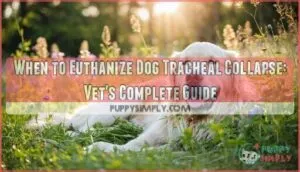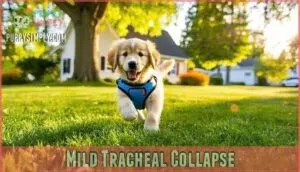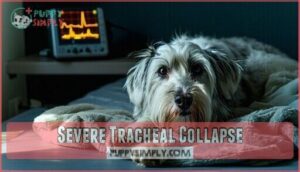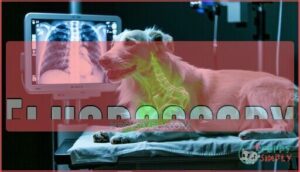This site is supported by our readers. We may earn a commission, at no cost to you, if you purchase through links.

If your pup can’t catch their breath even at rest, experiences frequent blue-tinged gums, or seems more exhausted than happy, you’re facing one of pet ownership’s toughest calls.
This isn’t about giving up—it’s about love. When medications no longer help and your dog’s tail-wagging joy fades into labored breathing, quality of life becomes the compass.
Your vet can help assess whether your furry friend is suffering more than living. Understanding the specific warning signs that signal this crossroads can guide your heart through this difficult decision, and it’s a decision made out of tough calls, considering the constant struggle, and the importance of tail-wagging joy in your dog’s life.
Table Of Contents
- Key Takeaways
- Dog Tracheal Collapse
- When Euthanize Dog
- Tracheal Collapse Stages
- Tracheal Collapse Diagnosis
- Tracheal Collapse Treatment
- Tracheal Collapse Prognosis
- Euthanizing Dog Considerations
- Tracheal Collapse Management
- End of Life Care
- Frequently Asked Questions (FAQs)
- What is the end stage of tracheal collapse in dogs?
- How should a dog sleep with a collapsed trachea?
- How do you know when your dog’s collapsed trachea is getting worse?
- Can a dog suffocate from collapsed trachea?
- Can tracheal collapse be prevented in puppies?
- What breeds are most at risk besides toy breeds?
- How much does tracheal collapse surgery typically cost?
- Are there natural remedies for tracheal collapse symptoms?
- Can dogs with tracheal collapse still exercise safely?
- Conclusion
Key Takeaways
- You’ll know it’s time when your dog can’t breathe comfortably even at rest, shows blue gums frequently, or collapses during minimal activity despite medical treatment.
- You should evaluate your dog’s quality of life using specific markers – can they still enjoy eating, sleeping, and gentle interaction without constant distress from breathing struggles.
- You’re not giving up when medications stop working and your dog’s joy fades into labored breathing – this decision comes from love and prevents unnecessary suffering.
- You’ll need to work with your vet to assess whether treatments are prolonging meaningful life or just extending suffering, especially when tracheal collapse reaches severe stages, to ensure you’re making a decision that comes from a place of care.
Dog Tracheal Collapse
If you’ve noticed your small dog making that distinctive "goose honk" cough, especially during excitement or exercise, you’re likely witnessing tracheal collapse in action.
This progressive condition occurs when the cartilage rings supporting your dog’s windpipe weaken and collapse inward, making it increasingly difficult for your pet to breathe normally, which is a result of the collapse.
Tracheal Collapse Definition
Picture your dog’s trachea as a flexible tube connecting their throat to lungs, supported by cartilage rings.
Tracheal collapse occurs when these rings weaken, causing airway obstruction during breathing.
This progressive disease primarily affects small breeds due to breed predisposition and congenital factors.
The weakened cartilage can’t maintain proper airway shape, leading to breathing difficulties that worsen over time, which is a result of tracheal collapse.
Tracheal Collapse Causes
Your dog’s tracheal collapse stems from cartilage weakening that can’t support the windpipe properly.
This congenital disorder affects small breed dogs most often, though acquired conditions like obesity can worsen the problem.
Understanding these genetic factors helps you recognize why certain breeds face higher risks.
- Breed predisposition – Yorkshire Terriers, Chihuahuas, and Pomeranians inherit weaker tracheal cartilage
- Congenital factors – Born with abnormal cartilage production affecting windpipe strength
- Acquired conditions – Respiratory infections and heart disease gradually weaken tracheal support
- Obesity impact – Extra weight puts additional pressure on already compromised airways
Tracheal Collapse Symptoms
Recognizing tracheal collapse symptoms early helps you make informed decisions about your dog’s care.
You’ll notice a distinctive "honking" cough that worsens with excitement or exercise.
Breathing difficulty becomes apparent during walks, while cyanosis signs like blue gums indicate oxygen deprivation.
Exercise intolerance develops as cough triggers multiply, and symptom progression can signal when quality of life discussions become necessary.
When Euthanize Dog
Making the euthanasia decision for your dog with tracheal collapse requires careful consideration of multiple factors.
When love means letting go, your heart knows what your mind struggles to accept.
You’ll need to evaluate your pet’s current condition alongside practical realities that affect your entire family.
Consider these key factors when contemplating pet euthanasia:
- Quality assessment – Can your dog still enjoy basic activities like eating, sleeping, and gentle interaction without constant distress?
- Financial burden – Are ongoing treatments creating unsustainable costs that compromise your family’s wellbeing?
- Emotional toll – Is watching your pet struggle causing severe distress to family members, especially children?
- Ethical considerations – Would continuing treatment prolong suffering rather than meaningful life?
The when to euthanize question doesn’t have easy answers.
Family consensus matters tremendously in this dog end of life situation.
Your veterinarian can guide you through this euthanasia decision, but ultimately, you know your pet best and understand what compassionate care means for your specific circumstances.
Tracheal Collapse Stages
Understanding your dog’s tracheal collapse stage helps you make informed decisions about treatment and quality of life.
Veterinarians classify this condition into four stages, from mild symptoms that barely affect daily activities to critical collapse that threatens your pet’s ability to breathe, which is crucial for their quality of life.
Mild Tracheal Collapse
At the early stages of dog tracheal collapse, your pup’s still living their best life with just occasional honking coughs.
Early detection means you can start lifestyle changes like switching to harnesses and managing weight.
Mild exercise remains possible, though you’ll need monitoring progression carefully.
Cough management becomes key – mild symptoms don’t threaten quality of life yet, and lifestyle changes can make a difference, including cough management.
Moderate Tracheal Collapse
At the moderate stage, your dog’s tracheal collapse symptoms become more noticeable.
Your dog’s breathing struggles shift from occasional concern to daily heartbreak as collapse progresses.
The windpipe shows pronounced sagging with 50% airflow reduction, making breathing difficulty apparent during normal activities.
Cough management becomes challenging as barking and poor air quality trigger frequent episodes.
Quality of life starts declining, though tracheal collapse treatment options remain effective.
- Your once-energetic companion now struggles with simple walks around the block
- That distinctive honking cough interrupts peaceful family moments more often
- You notice your dog avoiding activities they previously loved doing together
- Their labored breathing after mild excitement breaks your heart every time
Severe Tracheal Collapse
With severe tracheal collapse, your dog’s windpipe narrows by 75%, creating significant breathing difficulty and constant coughing that medication can’t control.
End-stage symptoms include blue gums and collapse during minimal activity, which dramatically increases the need for emergency interventions.
Emergency interventions become frequent, while surgical complications increase dramatically, leading to a rapid deterioration in the dog’s quality of life.
Quality of life deteriorates rapidly as palliative options offer limited relief, raising serious ethical considerations about your pet’s suffering, and many owners consider home euthanasia options to minimize distress.
Critical Tracheal Collapse
Critical tracheal collapse represents the final stage where your dog’s windpipe nearly closes completely.
End-stage symptoms include constant respiratory failure, blue gums, and collapse during minimal activity.
Emergency interventions like oxygen therapy provide temporary relief, but palliative options become limited.
Ethical considerations around euthanasia for dogs become paramount when severe tracheal collapse destroys quality of life permanently.
The condition involves weakened cartilage rings, which flatten and disrupt airflow, leading to a significant impact on the dog’s quality of life and causing respiratory failure.
Tracheal Collapse Diagnosis
Getting the right diagnosis for your dog’s tracheal collapse requires a combination of tests that work together like pieces of a puzzle.
Your vet will use physical exams, medical history, X-rays, and specialized procedures like tracheoscopy to determine exactly what’s happening in your pet’s airway.
Physical Exams
Your vet will conduct a thorough hands-on examination to assess your dog’s breathing difficulties.
They’ll listen carefully to your pet’s chest and feel for abnormalities that signal tracheal collapse.
During the physical examination, your veterinarian will focus on:
- Auscultation findings – Using a stethoscope to detect abnormal breathing sounds, wheezing, or harsh respiratory noises
- Palpation techniques – Gently feeling the neck area to identify tracheal abnormalities or sensitivity
- Respiratory rate – Counting breaths per minute to determine if your dog’s breathing is labored or rapid
- Cyanosis detection – Checking gums and tongue color for blue tinges indicating oxygen deprivation.
This veterinary care approach helps determine your dog’s general condition and whether breathing problems affect their quality of life, guiding decisions about ongoing treatment or potential euthanasia for dogs with severe symptoms.
Medical History
Your vet will ask about your dog’s breed predisposition and age onset since toy breeds face higher risks.
They’ll review prior conditions like heart disease and examine treatment history to understand progression rate.
This medical history helps assess quality of life decline and guides the dog euthanasia decision.
Honest answers about your pet’s daily struggles inform proper veterinary care recommendations.
X-rays and Tracheoscopy
After gathering your dog’s medical history, your vet will likely recommend imaging tests.
X-rays show the trachea’s structure but have X-ray limitations in detecting mild collapse.
Tracheoscopy provides detailed views but carries Anesthesia concerns and Tracheoscopy risks.
Image interpretation requires expertise, and Alternative imaging may be necessary for accurate tracheal collapse prognosis and veterinary guidance in decision-making about quality of life.
- Watching your beloved companion struggle to breathe during diagnostic procedures
- Feeling helpless as standard X-rays might miss early-stage collapse signs
- Worrying about anesthesia risks during tracheoscopy for your already fragile pet
- Questioning whether to euthanize if imaging reveals extensive tracheal damage
- Desperately hoping diagnostic results will guide the right treatment path forward
Fluoroscopy
Fluoroscopy provides real-time imaging that captures your dog’s tracheal movement during breathing cycles.
This dynamic test reveals collapse patterns that static X-rays miss, offering key fluoroscopy benefits for diagnosis accuracy.
While radiation exposure exists, the brief procedure poses minimal fluoroscopy risks. Your vet’s image interpretation helps determine disease severity, guiding treatment decisions and evaluating quality of life for potential euthanasia considerations.
Tracheal Collapse Treatment
You’ve got several treatment paths available once your vet confirms your dog’s tracheal collapse diagnosis.
The approach you’ll take depends on your dog’s specific symptoms and how severe the collapse has become, ranging from medications that ease breathing to surgical options that can add years to your pet’s life.
Medical Management
When your dog faces tracheal collapse, medical management becomes your first line of defense.
Bronchodilator efficacy varies, while antitussive options like hydrocodone provide cough relief.
However, steroid side-effects require careful monitoring, and antibiotic resistance can complicate treatment.
Many pet owners also explore additional bronchodilator options for their dogs.
Combination therapies often work best, but you’ll need to evaluate quality of life regularly to determine if medical management remains effective.
Surgical Repair
When medical treatments aren’t enough, surgical repair offers hope for your dog’s breathing struggles.
Ring placement and stent procedures provide structural support, with 30% of dogs becoming symptom-free and 61% showing marked improvement.
While surgical intervention costs start around $3,000, the recovery timeline and surgical alternatives like nitinol stents can substantially improve quality of life before considering euthanasia.
Weight Management
Effective weight management serves as your dog’s lifeline when battling tracheal collapse. Excess pounds create crushing pressure on an already compromised windpipe, making every breath a struggle.
Here’s your action plan for breathing improvement:
- Dietary Adjustments – Switch to low-calorie, high-protein food
- Exercise Regimen – Short, gentle walks instead of vigorous play
- Obesity Risks – Monitor weight weekly to prevent dangerous fluctuations
- Joint Stress – Reduce impact on weakened cartilage structures
- Veterinary Care – Regular check-ups guarantee a high quality of life
Consider using specialized dog food to help manage your dog’s weight.
Limiting Triggers
Beyond weight management, you’ll need to identify and avoid environmental triggers that worsen your dog’s breathing.
Poor air quality, cigarette smoke, and allergens can spark dangerous coughing fits.
Switch to a harness instead of a collar to reduce throat pressure, and control temperature exposure – hot, humid days are particularly challenging.
These simple changes substantially impact your dog’s quality of life and may delay difficult euthanasia decisions regarding dog tracheal collapse.
Tracheal Collapse Prognosis
Understanding your dog’s prognosis helps you make informed decisions about their care and future treatment options.
The outlook varies substantially based on the collapse stage, your dog’s response to treatment, and their overall health condition.
Life Expectancy
Understanding your dog’s life expectancy helps you make informed decisions about their care.
The progressive nature of tracheal collapse means timelines vary substantially based on several factors:
- Post-surgery lifespan averages around 879 days with stent longevity
- Medical management can extend life by 2-3 years
- Breed predisposition affects individual outcomes
Treatment timing impacts survival rates considerably.
Quality of Life
Throughout tracheal collapse progression, your dog’s quality of life becomes the compass guiding difficult decisions.
Watch how breathing comfort affects daily activities like eating and playing.
Pain management becomes essential when chronic coughing disrupts sleep.
Mental wellbeing suffers when social interaction decreases.
Small breeds are predisposed to this condition.
Using a pet quality of life scale helps evaluate when dog euthanasia decision becomes necessary for compassionate care.
Survival Rates
Medical management typically extends your dog’s life by 1-2 years, while stent survival rates show 86% of dogs living beyond 36 months post-surgery.
These numbers help guide your pet euthanasia decision when quality of life declines.
- Post-surgery survival averages 2-3 additional years with proper care
- Untreated collapse prognosis worsens rapidly, leading to suffocation
- Breed survival differences exist, with toy breeds facing higher risks
- Medical management lifespan varies based on symptom severity and response
Euthanizing Dog Considerations
Deciding when your dog’s tracheal collapse has progressed beyond manageable limits requires honest assessment of their daily struggles and remaining joy.
You’ll need to weigh factors like breathing difficulty, pain levels, and whether treatments still provide meaningful relief against the emotional toll of letting go, considering the emotional toll.
Severity of Symptoms
Recognizing when your dog’s tracheal collapse symptoms have reached critical levels helps you make informed decisions about their care.
Symptom progression from occasional coughing to constant breathing difficulty signals deterioration that may warrant considering euthanasia.
| Mild to Moderate Symptoms | Severe to Critical Symptoms |
|---|---|
| Occasional honking cough | Constant labored breathing at rest |
| Cough triggered by excitement | Frequent cyanosis (blue gums) |
| Some exercise intolerance | Complete exercise intolerance |
| Manageable breathing difficulty | Respiratory distress episodes |
| Responsive to medication | Medication no longer effective |
When cough frequency becomes relentless and cyanosis severity increases despite treatment, your dog’s quality of life substantially declines, making euthanasia a compassionate consideration.
Quality of Life Assessment
Your vet will use a pet quality of life scale to evaluate your dog’s Daily Activities, Breathing Comfort, and Social Interaction.
This assessment examines whether your dog still enjoys eating, playing, and connecting with family.
Pain Management becomes critical when dog breathing problems interfere with basic functions.
Your pet’s Emotional Wellbeing guides difficult decision-making about euthanasia timing.
Owners can also find peace by replacing guilt with grace during this challenging time, focusing on Daily Activities and Breathing Comfort to ensure a smooth transition, considering the overall Social Interaction.
Owner’s Decision
Making this heart-wrenching decision weighs heavily on your shoulders.
The emotional toll and financial strain create overwhelming owner burden, while ethical dilemmas challenge your love for your pet.
Consider these factors in your decisionmaking:
- Quality of life versus suffering levels
- Financial strain of ongoing treatments
- Family impact on daily routines
- Emotional toll on household members
- Pet grief support resources available
Tracheal Collapse Management
You can’t cure your dog’s tracheal collapse, but you can make life much easier with the right management approach.
Simple changes like switching to a harness, keeping your pup at a healthy weight, and avoiding smoky rooms can dramatically reduce those frightening coughing episodes.
This approach focuses on managing the condition to improve the dog’s quality of life.
Avoiding Airways Irritants
Environmental triggers can make your dog’s tracheal collapse symptoms worse, so you’ll need to become a detective about air quality.
Cigarette smoke is particularly harmful—it’s like adding fuel to fire.
Keep your home well-ventilated, consider an air purifier, and avoid harsh cleaning products.
Monitor humidity levels too, as stuffy air makes breathing harder for already struggling airways.
Switching to Harness
Traditional collars put dangerous pressure on your dog’s already weakened windpipe.
A properly fitted harness distributes pressure across the chest, giving your pup breathing relief when tracheal collapse strikes.
Many owners find relief using a specialized dog harness.
Harness Benefits for dogs with breathing difficulty:
- Reduced airway pressure – No direct contact with the sensitive tracheal area
- Better control – Easier walks without triggering coughing fits
- Improved quality of life – Less respiratory distress during daily activities
Maintaining Healthy Weight
Extra pounds put serious pressure on your dog’s already compromised trachea.
Weight management becomes essential for breathing comfort.
Monitor your pet’s weight regularly and adjust their diet accordingly.
Portion control prevents obesity risks while meeting dietary needs.
Create a gentle exercise regimen that doesn’t trigger coughing fits.
Even modest weight loss can dramatically improve your dog’s breathing and overall quality of life.
Smaller breeds are at higher risk, but early diagnosis matters for any dog.
Limiting Heat Exposure
Keeping your dog cool matters, especially with tracheal collapse.
Heat worsens breathing difficulty in dogs, so focus on comfort:
- Cooling Techniques: Use fans or cooling mats.
- Hydration Strategies: Make certain fresh water’s always available.
- Shade Importance: Provide shaded areas outdoors.
- Avoiding Peak Heat: Walk your dog early or late to avoid midday sun.
Their quality of life depends on it.
End of Life Care
When your dog’s tracheal collapse reaches its final stages, you’ll need to focus on comfort and quality rather than aggressive treatments.
This section covers palliative care options, hospice support, and the euthanasia process to help you make informed decisions during this difficult time.
Palliative Care
When your dog’s breathing becomes labored daily, palliative care focuses on comfort rather than cure.
You’ll manage pain with medications while creating a peaceful home environment. This compassionate approach reduces caregiver burden by emphasizing quality moments together.
| Comfort Strategy | Implementation | Benefit |
|---|---|---|
| Soft bedding elevation | Raise head during rest | Easier breathing |
| Gentle massage therapy | Light chest/neck strokes | Stress reduction |
| Quiet room setup | Minimal noise/activity | Calmer environment |
The use of comfort strategies like these can greatly improve your dog’s quality of life, and the quality moments you share together will be more enjoyable and meaningful.
Hospice Care
Hospice care transforms your home into a sanctuary where your dog’s final days unfold with dignity.
This compassionate approach focuses on comfort rather than cure, giving families precious time together while managing symptoms naturally.
- Comfort care prioritizes your dog’s peace over aggressive treatments
- Pain management keeps breathing easier without invasive procedures
- Home environment allows familiar surroundings during passage
- Family support helps everyone process emotions together
- Quality of life assessments guide daily care decisions
Euthanasia Procedure
When hospice care can no longer provide comfort, the euthanasia procedure offers a peaceful, humane option.
Your vet will explain the process beforehand and discuss aftercare options like cremation or burial.
The procedure involves a sedative followed by an overdose of anesthetic, ensuring your dog feels no pain.
Many owners find comfort in pre-paying the procedure to ease financial stress.
Grief support helps navigate pet loss during this difficult decision.
Frequently Asked Questions (FAQs)
What is the end stage of tracheal collapse in dogs?
Ironically, your dog’s final breath becomes their greatest struggle.
End-stage tracheal collapse brings complete airway closure, severe oxygen deprivation, constant respiratory distress, and inevitable suffocation.
You’ll witness blue gums, collapse, and life-threatening breathing crises requiring immediate intervention, which can be caused by severe oxygen deprivation.
How should a dog sleep with a collapsed trachea?
Elevate your dog’s head and chest using pillows or a wedge bed to improve airflow. Choose a cool, well-ventilated room and avoid soft bedding that might restrict breathing during sleep.
How do you know when your dog’s collapsed trachea is getting worse?
Studies show 75% of dogs with Grade 3 tracheal collapse experience severe breathing difficulties.
You’ll notice worsening when your dog’s cough becomes more frequent, breathing grows labored even at rest, and gums appear blue during episodes, indicating a potential tracheal collapse.
Can a dog suffocate from collapsed trachea?
Yes, dogs can suffocate from severe tracheal collapse when the windpipe narrows substantially or closes completely. Grade 4 collapse creates life-threatening breathing emergencies requiring immediate veterinary intervention to prevent asphyxiation.
Can tracheal collapse be prevented in puppies?
You can’t completely prevent tracheal collapse since it’s often genetic in toy breeds.
However, you can reduce risks by maintaining your puppy’s healthy weight, using harnesses instead of collars, and avoiding respiratory irritants to minimize the chance of tracheal collapse.
What breeds are most at risk besides toy breeds?
You can’t teach an old dog new tricks, but you can spot tracheal collapse early.
Besides toy breeds, brachycephalic dogs like Pugs, Bulldogs, and Boston Terriers face higher risks due to their flattened skulls and narrow airways.
How much does tracheal collapse surgery typically cost?
Tracheal collapse surgery typically costs around $3,000 and up, depending on your location and procedure type.
Stent placement and external ring procedures vary in price, so you’ll want to discuss options with your veterinarian.
Are there natural remedies for tracheal collapse symptoms?
Don’t put all your eggs in one basket with natural remedies alone.
While honey can soothe throat irritation and humidifiers ease breathing, you’ll still need veterinary medications for effective tracheal collapse management.
Can dogs with tracheal collapse still exercise safely?
Yes, you can exercise dogs with tracheal collapse, but keep it gentle and short.
Walk slowly, avoid hot weather, use a harness instead of collars, and watch for excessive panting or coughing.
Conclusion
Like choosing between two difficult paths, deciding when to euthanize a dog with tracheal collapse requires balancing love with compassion.
You’ve learned the warning signs—constant breathlessness, blue gums, and diminished joy.
Trust your veterinarian’s guidance and your dog’s behavior.
When medications fail and quality of life deteriorates, you’re not giving up—you’re giving the ultimate gift of peace.
Remember, this difficult decision reflects your deep love and commitment to ending suffering with dignity.
- https://www.merckvetmanual.com/special-pet-topics/drugs-and-vaccines/drugs-used-to-treat-lung-and-airway-disorders
- https://veterinarypartner.vin.com/default.aspx?pid=19239&id=4951966
- https://onlinelibrary.wiley.com/doi/abs/10.1111/j.1748-5827.1970.tb05579.x
- https://pubmed.ncbi.nlm.nih.gov/31115067/
- https://pawsatpeace.com/tracheal-collapse-in-dogs/




















